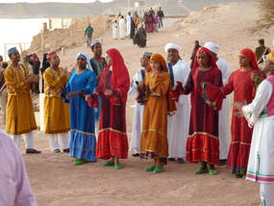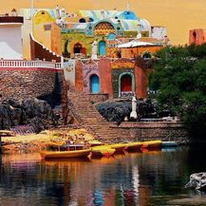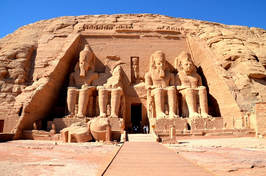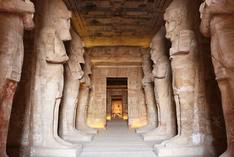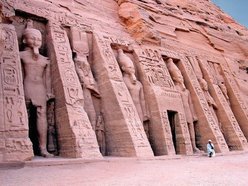|
The people of Egypt are an intelligent people with a glorious history who left their mark on civilization. -Fidel Castro |
Day 11:
Deeper Towards the Past
This morning you will take a private van to Aswan, a beautiful Southern city filled with Nubian mysteries, and your jumping off point to Abu Simbel.
Along the way you will stop by several Temples that fewer Travelers ever get to see.
this will be along 8-10 hour day, with several stops in between.
After you arrive in Aswan, you will go to your accommodations on the island by ferry where the Nubian people live. The original people of ancient Kemet and first rulers of this country.
Tonight will be an early night as you head out in the extreme early hours in the morning for our tour to Abu Simbel
______________________
Deeper Towards the Past
This morning you will take a private van to Aswan, a beautiful Southern city filled with Nubian mysteries, and your jumping off point to Abu Simbel.
Along the way you will stop by several Temples that fewer Travelers ever get to see.
this will be along 8-10 hour day, with several stops in between.
After you arrive in Aswan, you will go to your accommodations on the island by ferry where the Nubian people live. The original people of ancient Kemet and first rulers of this country.
Tonight will be an early night as you head out in the extreme early hours in the morning for our tour to Abu Simbel
______________________
Aswan
Aswan is the ancient city of Swenett, later known as Syene, which in antiquity was the frontier town of Ancient Egypt facing the south. Swenett is supposed to have derived its name from an Egyptian goddess with the same name. This goddess later was identified as Eileithyia by the Greeks and Lucina by the Romans during their occupation of Ancient Egypt because of the similar association of their goddesses with childbirth, and of which the import is "the opener".
Because the Ancient Egyptians oriented themselves toward the origin of the life-giving waters of the Nile in the south, and as Swenett was the southernmost town in the country, Egypt always was conceived to "open" or begin at Swenett. The city stood upon a peninsula on the right (east) bank of the Nile, immediately below (and north of) the first cataract of the flowing waters, which extend to it from Philae.
Because the Ancient Egyptians oriented themselves toward the origin of the life-giving waters of the Nile in the south, and as Swenett was the southernmost town in the country, Egypt always was conceived to "open" or begin at Swenett. The city stood upon a peninsula on the right (east) bank of the Nile, immediately below (and north of) the first cataract of the flowing waters, which extend to it from Philae.
Day 12:
Nubia Wanderings
In the morning you will explore the small vilages of the Nubians, and stop for lunch to get some goat stew, if you desire a visit to the Nubian Museum, dedicated to Nubian culture and civilization on Elephantine Island, and then wander some more and explore the Nubian Village to experience their culture. Maybe a felucca ride if the boatmen are willing.
Later we will come back to the hotel for relaxation
Tonight will be an early night as you head out in the extreme early hours in the morning for our tour to Abu Simbel
______________________
Nubia Wanderings
In the morning you will explore the small vilages of the Nubians, and stop for lunch to get some goat stew, if you desire a visit to the Nubian Museum, dedicated to Nubian culture and civilization on Elephantine Island, and then wander some more and explore the Nubian Village to experience their culture. Maybe a felucca ride if the boatmen are willing.
Later we will come back to the hotel for relaxation
Tonight will be an early night as you head out in the extreme early hours in the morning for our tour to Abu Simbel
______________________
NUbian culture
An ethnolinguistic group indigenous to present-day Sudan and southern Egypt who originate from the early inhabitants of the central Nile valley, believed to be one of the earliest cradles of civilization. They speak Nubian languages, part of the Northern Eastern Sudanic languages.
Early Neolithic settlements from prehistoric Egypt have been found in the central Nubian region dating back to 7000 BC, with Wadi Halfa believed to be the oldest settlement in the central Nile valley. Parts of Nubia, such as Ta-Seti, were continuously a part of ancient Egypt throughout the dynastic era. Other parts of Nubia, particularly Southern or Upper Nubia, were at times a part of ancient Pharaonic Egypt and at other times a rival state representing parts of Meroë or the Kingdom of Kush. However, by the Twenty-fifth Dynasty, all of Nubia was united with Egypt, extending down to what is now Khartoum.
The prehistory of Nubia dates to the Paleolithic around 300,000 years ago. By about 6000 BCE, peoples in the region had developed an agricultural economy. They began using a system of writing relatively late in their history, when they adopted the Egyptian hieroglyphic system.
Early Neolithic settlements from prehistoric Egypt have been found in the central Nubian region dating back to 7000 BC, with Wadi Halfa believed to be the oldest settlement in the central Nile valley. Parts of Nubia, such as Ta-Seti, were continuously a part of ancient Egypt throughout the dynastic era. Other parts of Nubia, particularly Southern or Upper Nubia, were at times a part of ancient Pharaonic Egypt and at other times a rival state representing parts of Meroë or the Kingdom of Kush. However, by the Twenty-fifth Dynasty, all of Nubia was united with Egypt, extending down to what is now Khartoum.
The prehistory of Nubia dates to the Paleolithic around 300,000 years ago. By about 6000 BCE, peoples in the region had developed an agricultural economy. They began using a system of writing relatively late in their history, when they adopted the Egyptian hieroglyphic system.
Day 13:
The Temple of Isis
Today you will take a taxi to catch a boat to Philae Island where we will explore The Isis Temple, built in the reign of Nectanebo I during 380-362 BC. This is a place to wander and explore the past, as the temple is well preserved. If the weather is comfortable enough maybe we will hire a boat to go to the tombs of the nobles. Otherwise and still possible we can visit the Old Cataract Hotel, one of the decadent gems of the time of Howard Carter.
______________________
The Temple of Isis
Today you will take a taxi to catch a boat to Philae Island where we will explore The Isis Temple, built in the reign of Nectanebo I during 380-362 BC. This is a place to wander and explore the past, as the temple is well preserved. If the weather is comfortable enough maybe we will hire a boat to go to the tombs of the nobles. Otherwise and still possible we can visit the Old Cataract Hotel, one of the decadent gems of the time of Howard Carter.
______________________
Day 14:
Nomad Day
Today may hold one or more of several special Nomad experiences depending on availability. So this may be left as a mystery day.
Nomad Day
Today may hold one or more of several special Nomad experiences depending on availability. So this may be left as a mystery day.
Day 15:
Travels to Abu Simbel
In the extremely early morning at 3:30 am you will get picked up by a private vehicle to head to the most celebrated Temple of all of Egypt, Abu Simbel. It is around a 3 hour drive to the site with many military checkpoints long the way, which you will have clearance for. You will have several hours to explore this area before returning to Aswan. You will return about 12:30pm in the afternoon and then you can relax or wander the Sharia al-Souq in the center of Aswan's downtown district, it is a souvenir hunter's dream. The stalls brim with spices and perfumes galore, traditional galebeyas (long robes) and scarves in rainbow hues, basketry, and silverware.
______________________
Travels to Abu Simbel
In the extremely early morning at 3:30 am you will get picked up by a private vehicle to head to the most celebrated Temple of all of Egypt, Abu Simbel. It is around a 3 hour drive to the site with many military checkpoints long the way, which you will have clearance for. You will have several hours to explore this area before returning to Aswan. You will return about 12:30pm in the afternoon and then you can relax or wander the Sharia al-Souq in the center of Aswan's downtown district, it is a souvenir hunter's dream. The stalls brim with spices and perfumes galore, traditional galebeyas (long robes) and scarves in rainbow hues, basketry, and silverware.
______________________
Abu Simbel
The Abu Simbel temples are two massive rock temples at Abu Simbel, a village in Nubia, southern Egypt, near the border with Sudan. The complex is part of the UNESCO World Heritage Site known as the "Nubian Monuments", which run from Abu Simbel downriver to Philae. The twin temples were originally carved out of the mountainside in the 13th century BC, during the 19th dynasty reign of the Pharaoh Ramesses II. They serve as a lasting monument to the king and his queen Nefertari, and commemorate his victory at the Battle of Kadesh. Their huge external rock relief figures have become iconic.
The Great Temple at Abu Simbel, was completed around year 24 of the reign of Ramesses the Great (1265 BC). It was dedicated to the gods Amun, Ra-Horakhty, and Ptah, as well as to the deified Rameses himself. It is generally considered the grandest and most beautiful of the temples commissioned during the reign of Rameses II, and one of the most beautiful in Egypt.
The temple of Hathor and Nefertari, also known as the Small Temple, was built about one hundred meters northeast of the temple of pharaoh Ramesses II and was dedicated to the goddess Hathor and Ramesses II's chief consort, Nefertari. This was in fact the second time in ancient Egyptian history that a temple was dedicated to a queen. The first time, Akhenaten dedicated a temple to his great royal wife, Nefertiti. The rock-cut facade is decorated with two groups of colossi that are separated by the large gateway. The statues, slightly more than ten meters high, are of the king and his queen. On either side of the portal are two statues of the king, wearing the white crown of Upper Egypt and the double crown, these are flanked by statues of the queen.
As the larger temple dedicated to the king, the hypostyle hall or pronaos is supported by six pillars decorated with scenes with the queen playing the sistrum together with the gods Horus, Khnum, Khonsu, and Thoth, and the goddesses Hathor, Isis, Maat, Mut of Asher, Satis and Taweret.
]
Each temple had its own priest that represents the king in daily religious ceremonies. In theory, the Pharaoh would have been the only celebrant in daily religious ceremonies performed in different temples throughout Egypt. In reality, the high priest also played that role. To reach that position, an extensive education in art and science was necessary, like the one pharaoh had.



